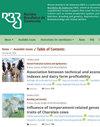Effects of milking system in suckling period on growth, reproduction traits, and milk yield of East Friesian-cross dairy sheep
IF 1.2
4区 农林科学
Q3 Agricultural and Biological Sciences
Revista Brasileira De Zootecnia-Brazilian Journal of Animal Science
Pub Date : 2022-01-01
DOI:10.37496/rbz5120210201
引用次数: 0
Abstract
- The main objective of this study was to determine the effects of milking system on growth, reproduction, and milk yield and composition of East Friesian-cross (Tahirova) dairy sheep that were milked in the evening during the suckling period. A total of 43 Tahirova ewes and 58 lambs were used in the present study. One of the groups was milked in the evening (evening milked; EM) before coming together with their lambs, and the other group was not (not milked in the evening; NEM). Morning milking was performed in both groups during the study. Lambs in both groups were individually weaned at the age of 60 days. There was no statistical difference between the lambs’ live weight at weaning in the EM and NEM groups, determined to be 23.46 and 24.11 kg, respectively. Live weight values of lambs were similar in the groups at ages of up to 180 days. The reproductive characteristics of ewe lambs in the EM and NEM groups, having similar growth rates and a similar live weight and body condition in the first estrus stages, were also similar. The return rate and frequency of return were close in both groups of ewe lambs. Milk yield of the NEM group was significantly higher than that of the EM group before and after weaning. However, in groups with similar lactation milk yield and length, the total marketable milk yield was higher in the suckling period of the EM group. The milking system in suckling period of Tahirova ewes does not significantly affect growth, average daily gain, and reproductive characteristics. Milk yield in the NEM group before and after weaning was significantly higher than the EM group, but the total marketable milk yield was higher in the EM group.哺乳期挤奶制度对东弗里西亚杂交奶羊生长、繁殖性状及产奶量的影响
-本研究的主要目的是确定挤奶系统对哺乳期夜间挤奶的东弗里西亚杂交(Tahirova)奶羊的生长、繁殖、产奶量和成分的影响。试验选用43只大田母羊和58只羔羊。其中一组在晚上挤奶(晚上挤奶;EM),另一组不(晚上不挤奶;NEM)。两组在研究期间都进行了早晨挤奶。两组羔羊分别在60日龄断奶。EM组和NEM组羔羊断奶时的活重分别为23.46和24.11 kg,差异无统计学意义。180日龄各组羔羊的活重相近。EM组和NEM组母羊的繁殖特征也相似,在发情初期具有相似的生长率和相似的活重和体况。两组母羊的回归率和回归频率接近。NEM组断奶前后产奶量均显著高于EM组。然而,在泌乳量和泌乳长度相似的组中,EM组的哺乳期总可售产奶量更高。哺乳期挤奶制度对大田母羊的生长、平均日增重和繁殖特性影响不显著。NEM组断奶前后产奶量均显著高于EM组,但总产奶量高于EM组。
本文章由计算机程序翻译,如有差异,请以英文原文为准。
求助全文
约1分钟内获得全文
求助全文
来源期刊
CiteScore
1.90
自引率
0.00%
发文量
25
审稿时长
8 weeks
期刊介绍:
The Revista Brasileira de Zootecnia (RBZ; Brazilian Journal of Animal Science) encompasses all fields of Animal Science Research. The RBZ publishes original scientific articles in the areas of Aquaculture, Biometeorology and Animal Welfare, Forage Crops and Grasslands, Animal and Forage Plants Breeding and Genetics, Animal Reproduction, Ruminant and Non-Ruminant Nutrition, and Animal Production Systems and Agribusiness.

 求助内容:
求助内容: 应助结果提醒方式:
应助结果提醒方式:


